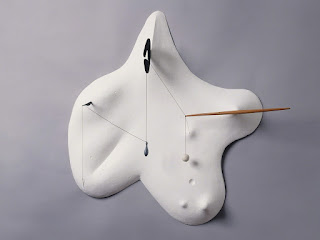V: Rodin at the Met
 Upon approaching the grand steps of the Metropolitan Museum of Art, the sight of the massive banner emblazoned with Rodin’s name filled me with anticipation of an impressive exhibit. After navigating the always confusing layout of the museum, I came upon the exhibit in the same old place where Rodin’s work had normally resided. This same old location quickly curtailed my enthusiasm and set the tone for the exhibit as being the same old Rodin stuff. It is not clear as to which pieces were normally on display in the corridor where the exhibition took place but there certainly seemed to be either more work or more people in the gallery than normal as it was awfully crowded. The flow of traffic also made one feel like they were in the intersection of a street as people were moving in all different directions, some just walking through to get to another part of the museum. It was interesting that the effort was not made to put the work in a more hospitable open space but maybe this had to do with the fact that a lot of the pieces were small and in display cases. Although cramped at times and not really displaying work I had never seen before, other than the drawings that were on display, the exhibit contained some writing that was rather informative and insightful about the work of Rodin. Explanations of his process and interest in the nude figure were discussed on a few of the tags which made the exhibit a bit more interesting.
Upon approaching the grand steps of the Metropolitan Museum of Art, the sight of the massive banner emblazoned with Rodin’s name filled me with anticipation of an impressive exhibit. After navigating the always confusing layout of the museum, I came upon the exhibit in the same old place where Rodin’s work had normally resided. This same old location quickly curtailed my enthusiasm and set the tone for the exhibit as being the same old Rodin stuff. It is not clear as to which pieces were normally on display in the corridor where the exhibition took place but there certainly seemed to be either more work or more people in the gallery than normal as it was awfully crowded. The flow of traffic also made one feel like they were in the intersection of a street as people were moving in all different directions, some just walking through to get to another part of the museum. It was interesting that the effort was not made to put the work in a more hospitable open space but maybe this had to do with the fact that a lot of the pieces were small and in display cases. Although cramped at times and not really displaying work I had never seen before, other than the drawings that were on display, the exhibit contained some writing that was rather informative and insightful about the work of Rodin. Explanations of his process and interest in the nude figure were discussed on a few of the tags which made the exhibit a bit more interesting.
I enjoyed seeing and experiencing the difference between Rodin’s earliest work and later work. This could be seen in the comparison of his first major work, The Age of Bronze modeled in 1876 and a lesser known Fallen Caryatid Carrying an Urn modeled in 1883. The Age of Bronze is an interesting work with an interesting backstory, but just formally there is a lot to be said about Rodin’s work at that point in time. There is a clear link to classical Greek and Roman sculpture in with the work. The figure is modeled with astonishing accuracy and realism in a contrapposto pose reminiscent of this classic influence. The spear that should be in the soldier’s hand is no longer there as if the sculpture was itself an ancient relic much like Polykleitos’ Doryphoros or Spear Barer which also is lacking a spear that had been actually destroyed with time. The poses of The Age of Bronze and the Doryphoros are relatively similar in that they are both men holding spears in a contrapposto stance yet there is something distinctly different about the emotions they each project. The Doryphoros stands stoically and stolidly where The Age of Bronze grasps at his hair with his mouth open in anguish. One idealizes and celebrates the human form and act of war while the other describes the two with sobering realism. The Age of Bronze seems to be gently playing with the concept of reinterpreting past depictions of an idealized form of an innately flawed subject.
Fallen Caryatid Carrying an Urn handles this concept in a more deliberate way. A caryatid is an architectural support that is, traditionally, carved in the form of a woman. These were first conceived in 5th century Greece and consequently were sculpted in a classical manner. Rodin takes this concept of a human form as a supportive structure and creates a literal antithesis of it, the same traditional figure collapsing under the weight of an urn. Rodin progressed more in the direction of symbolistic and allegorical work. Does the woman represent mankind under some kind of burden? Surely Fallen Caryatid Carrying an Urn fits into the visual trend of representations of human despondency and has a clear root and progression from The Age of Bronze.
#hadpratt, #hadsopratt, #hadstories, #hadhistoryofsculpture



Comments
Post a Comment